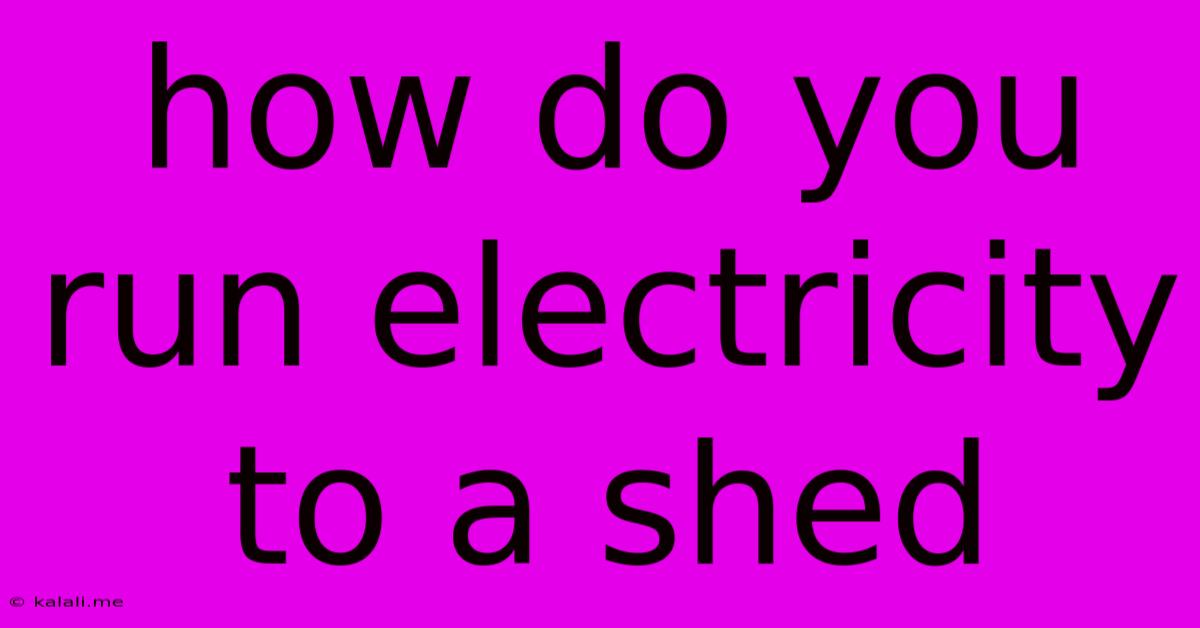How Do You Run Electricity To A Shed
Kalali
May 21, 2025 · 4 min read

Table of Contents
How to Run Electricity to Your Shed: A Comprehensive Guide
Running electricity to your shed can significantly enhance its functionality, transforming it from a simple storage space into a workshop, home office, or even a guest house. This guide will walk you through the process, covering safety precautions, necessary materials, and step-by-step instructions to ensure a safe and efficient installation. Remember, if you're not comfortable working with electricity, it's always best to hire a qualified electrician.
Understanding the Risks and Regulations: Working with electricity poses inherent risks. Improper wiring can lead to electrical shocks, fires, and damage to your property. Always adhere to local building codes and electrical regulations. These regulations vary by location, so researching your area's specific requirements is crucial before starting the project. This article provides general guidance; it's not a substitute for professional advice or local regulations.
Assessing Your Needs and Planning the Installation
Before you begin, carefully consider your shed's electrical needs. How many outlets will you need? Will you be using power tools? This will determine the amperage and gauge of wire required. You'll also need to plan the route of the wiring, considering factors like distance from the main power source, potential obstacles, and the aesthetics of the installation. Sketching a simple diagram can be incredibly helpful.
Gathering the Necessary Materials
You'll need several key materials for this project:
- Appropriate Gauge Wiring: The gauge of the wire depends on the amperage required. Consult a qualified electrician or an electrical code reference to determine the correct gauge for your specific needs. Consider using outdoor-rated wire suitable for direct burial or conduit protection.
- Electrical Conduit (optional but recommended): Conduit protects the wiring from damage and the elements. PVC conduit is a common and relatively inexpensive option.
- Junction Boxes: These are essential for safely connecting wires and providing a point for future maintenance.
- Outlets and Switches: Choose outlets and switches rated for outdoor use if the wiring will be exposed to the elements. Consider weatherproof covers for added protection.
- Grounding Rod and Wire: Proper grounding is crucial for safety and preventing electrical shocks.
- Circuit Breaker: This safety device protects the circuit from overloads and shorts.
- Wire Connectors: Use appropriate wire connectors for secure and safe connections.
- Cable Clamps: Secure the cables to the conduit to prevent movement and damage.
- Digging Tools (if burying cable): A shovel or post hole digger will be necessary if burying the cable.
Step-by-Step Installation Guide
- Turn Off Power: This is the most crucial step. Turn off the power at the main breaker panel before starting any work.
- Run the Wiring: Carefully run the wiring from your main electrical panel to the shed. If burying the cable, dig a trench deep enough to protect the cable from damage. Always use conduit for added protection and adherence to code.
- Install Junction Boxes: Install junction boxes at strategic points along the wiring route to allow for easy access to connections and future modifications.
- Connect the Wiring: Carefully connect the wires within the junction boxes, ensuring secure and proper connections. Follow all safety guidelines and use appropriate connectors.
- Install Outlets and Switches: Install the outlets and switches in your shed, ensuring proper grounding and connection to the wiring.
- Grounding: Install a grounding rod near the shed and connect it to the grounding wire. This is critical for safety.
- Circuit Breaker Installation: Install the appropriate circuit breaker in your main electrical panel to control the shed's circuit.
- Turn Power Back On: Once all connections are complete, carefully turn the power back on at the main breaker panel.
- Test the Installation: Thoroughly test all outlets and switches to ensure they are functioning correctly. If you encounter any problems, immediately turn off the power and consult a qualified electrician.
Maintaining Your Shed's Electrical System
Regularly inspect your shed's electrical system for any signs of damage or wear. Replace any damaged or worn components promptly. Never overload circuits, and be aware of potential hazards such as water damage.
Running electricity to your shed can greatly increase its utility and value. By following these steps and prioritizing safety, you can enjoy a safe and functional workspace. Remember, if you’re unsure about any aspect of this process, it’s always best to seek professional help from a qualified electrician. They can ensure your installation meets all local regulations and is safe and effective.
Latest Posts
Latest Posts
-
How To Get Dog Hair Out Of A Washing Machine
May 22, 2025
-
Man In The High Castle World Map
May 22, 2025
-
Why Do Jehovah Witnesses Not Celebrate Birthdays
May 22, 2025
-
Doctor Who Crack In The Wall
May 22, 2025
-
Best Filler For Cracks In Plaster Walls
May 22, 2025
Related Post
Thank you for visiting our website which covers about How Do You Run Electricity To A Shed . We hope the information provided has been useful to you. Feel free to contact us if you have any questions or need further assistance. See you next time and don't miss to bookmark.